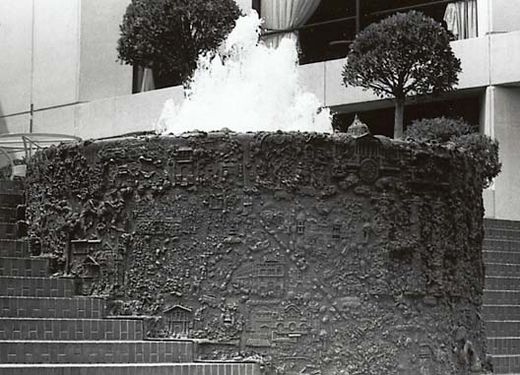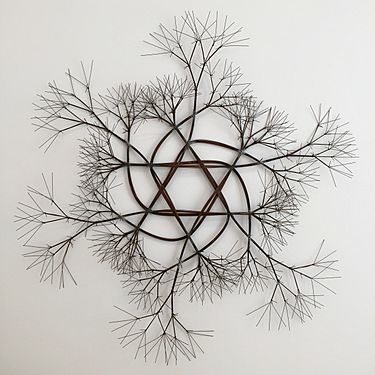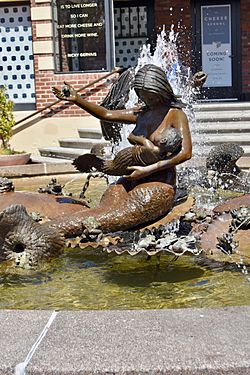Ruth Asawa facts for kids
Quick facts for kids
Ruth Asawa
|
|
|---|---|
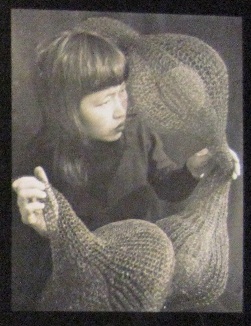
Asawa in 1952
|
|
| Born |
Ruth Aiko Asawa
January 24, 1926 Norwalk, California, U.S.
|
| Died | August 5, 2013 (aged 87) |
| Education | Black Mountain College |
| Known for | Sculpture |
| Spouse(s) |
Albert Lanier
(m. 1949; |
Ruth Aiko Asawa (January 24, 1926 – August 5, 2013) was an American artist known for her amazing wire sculptures. Her artworks are displayed in famous museums like the Solomon R. Guggenheim Museum and the Whitney Museum of American Art in New York City. You can see fifteen of her wire sculptures permanently at the de Young Museum in Golden Gate Park, San Francisco. She also created several public fountains in San Francisco.
Ruth Asawa was a strong supporter of art education. She helped create the San Francisco School of the Arts, which was later renamed the Ruth Asawa San Francisco School of the Arts in her honor in 2010. In 2020, the U.S. Postal Service even released a series of ten stamps featuring her well-known wire sculptures.
Contents
Early Life and Education
Ruth Aiko Asawa was born in 1926 in Norwalk, California. She was one of seven children. Her parents were immigrants from Japan and ran a farm. During World War II, many Japanese Americans, including Ruth's family, were forced to move to special camps. This was called Japanese American internment. Ruth's father was arrested by the FBI and held in a different camp for six years. The rest of her family was sent to a camp in Arkansas. Ruth's younger sister was in Japan visiting family and could not return to the U.S. during the war.
Asawa loved art from a young age. Her third-grade teacher encouraged her to create art. In 1939, she won first prize in a school art competition for her work about what it means to be American.
After finishing high school at the internment camp, Asawa wanted to become an art teacher. She went to Milwaukee State Teachers College in Wisconsin. She couldn't attend college in California because of the war. She faced challenges getting a teaching job because of racial discrimination. She left college without a degree, though Wisconsin later gave it to her in 1998. Asawa experienced racism, but she found more equality at Black Mountain College. This helped her develop a strong sense of social awareness in her art.
Before her last year in Milwaukee, Asawa traveled to Mexico. She took an art class where she learned about Black Mountain College. From 1946 to 1949, she studied there with artist Josef Albers. Albers taught her to use everyday materials and encouraged her to experiment with wire. At Black Mountain College, she studied many different art forms. This helped shape her unique artistic style. She was especially inspired by dance classes with Merce Cunningham.
Career as an Artist
In the 1950s, while at Black Mountain College, Ruth Asawa started making her famous wire sculptures. These sculptures looked like crocheted abstract shapes. She began with basket designs and then created hanging forms that looked like natural shapes. She learned the wire-crocheting technique during a trip to Mexico in 1947. Villagers there used a similar method to make baskets from wire.
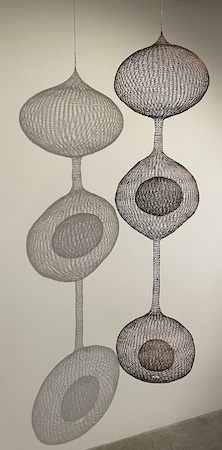
Asawa's wire sculptures made her famous in the 1950s. Her work was shown in important exhibitions like the Whitney Biennial and at the San Francisco Museum of Modern Art. She said her sculptures explored the idea of "a shape that was inside and outside at the same time." She believed in experimenting to find her own artistic style. Since she was a poor student, she used inexpensive materials like rocks, leaves, and sticks.
In the 1960s, Asawa started making sculptures with tied wire. These often looked like branching forms from nature. She also began getting requests for large sculptures in public places. Her first public sculpture, *Andrea* (1968), was a fountain with two bronze mermaids in Ghirardelli Square in San Francisco. This artwork caused some debate, but many people, especially women, supported it. Asawa said it would bring back childhood memories for older people and create new ones for the young.
She also created a fountain near Union Square in San Francisco. For this project, she worked with 200 schoolchildren. They molded images of the city in dough, which were then cast in iron. Over time, she designed other public fountains and became known in San Francisco as the "fountain lady."
Public Service and Art Education
Ruth Asawa strongly believed that art education could change lives, especially for children. In 1968, she joined the San Francisco Arts Commission. She worked hard to get support for art programs for young people. She helped start the Alvarado Arts Workshop for schoolchildren in 1968. This program became a model for other art programs across the country.
The Alvarado approach combined art with gardening, similar to Asawa's own childhood on a farm. She believed in "learning by doing" and that children should learn from professional artists. She felt that regular teachers had too many other duties to teach art well. A large part of the program's money went to hiring artists to teach the students.
In 1982, this led to the creation of the San Francisco School of the Arts. It was renamed the Ruth Asawa San Francisco School of the Arts in her honor in 2010. Asawa also served on important art councils, like the California Arts Council and the National Endowment for the Arts. She felt that art education was a very important part of her life's work.
Personal Life
In July 1949, Ruth Asawa married Albert Lanier, an architect. They met at Black Mountain College. They had six children: Xavier, Aiko, Hudson, Adam, Addie, and Paul. Albert Lanier passed away in 2008. Asawa believed that "Children are like plants. If you feed them and water them generally they'll grow." At the time they married, marriages between people of different races were only legal in a few states. The family moved to San Francisco in 1960, where Asawa was very active in her community.
Death
Ruth Asawa passed away peacefully at her home in San Francisco on August 5, 2013. She was 87 years old.
Awards and Honors
- In 2010, the School of the Arts High School in San Francisco was renamed Ruth Asawa San Francisco School of the Arts in her honor.
- In 2020, the United States Postal Service released a set of postage stamps to honor Ruth Asawa.
- A Google Doodle on May 1, 2019, celebrated Ruth Asawa for Asian Pacific American Heritage Month.
- The Crochet Guild of America recognized Asawa as an inspiring pioneer in the crochet community.
Selected Works
-
Ruth Asawa's San Francisco Fountain at the Grand Hyatt San Francisco
-
Andrea, the mermaid fountain at Ghirardelli Square (1966)
- Andrea (1966), the mermaid fountain at Ghirardelli Square, San Francisco, California
- Fountain (1973), The Hyatt on Union Square, San Francisco, California
- Fountains (1976), The Buchanan Mall (Nihonmachi), San Francisco, California
- Aurora (1986), an origami-inspired fountain on the San Francisco waterfront.
- The Japanese-American Internment Memorial Sculpture (1994) in San Jose, California
- The Garden of Remembrance (2002) at San Francisco State University, San Francisco, California
Awards
- 1966: First Dymaxion Award for Artist/Scientist
- 1974: Gold Medal from the American Institute of Architects
- 1990: San Francisco Chamber of Commerce Cyril Magnin Award
- 1993: Honor Award from the Women's Caucus for the Arts
- 1995: Asian American Art Foundations Golden Ring Lifetime Achievement Award
- 2002: Honorary doctorate by San Francisco State University
- Since 1982, San Francisco has declared February 12 to be "Ruth Asawa Day"
Film
- Snyder, Robert, producer (1978) Ruth Asawa: On Forms and Growth, Pacific Palisades, CA: Masters and Masterworks Production
- Soe, Valerie, and Ruth Asawa directors (2003) Each One Teach One: The Alvarado School Art Program, San Francisco: Alvarado Arts Program.
See also
 In Spanish: Ruth Asawa para niños
In Spanish: Ruth Asawa para niños


